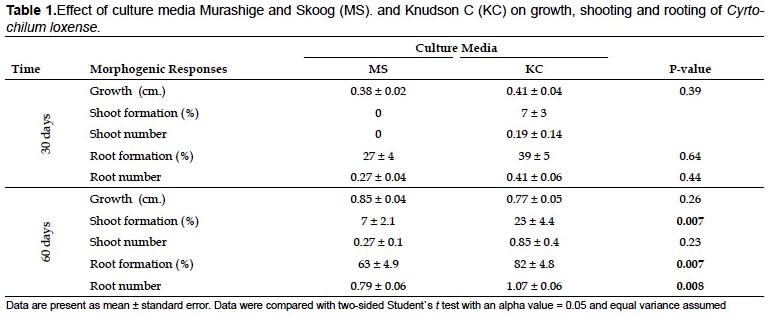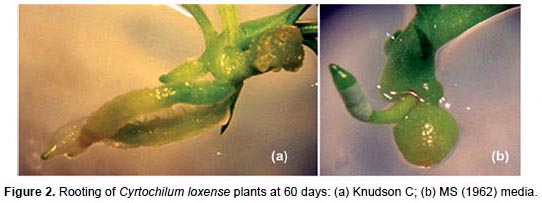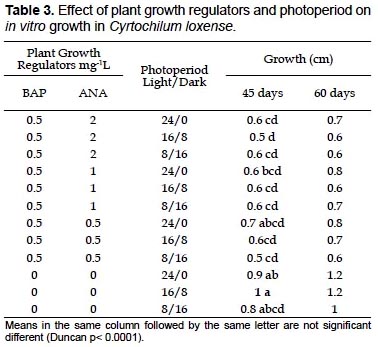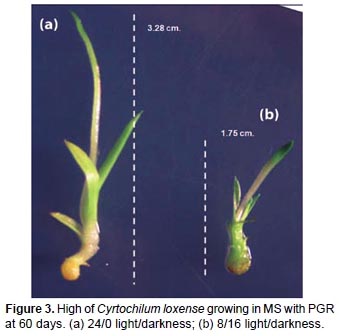Servicios Personalizados
Revista
Articulo
Indicadores
-
 Citado por SciELO
Citado por SciELO
Links relacionados
-
 Similares en
SciELO
Similares en
SciELO  uBio
uBio
Compartir
Revista Peruana de Biología
versión On-line ISSN 1727-9933
Rev. peru biol. vol.21 no.2 Lima ago. 2014
http://dx.doi.org/10.15381/rpb.v21i2.9826
NOTA CIENTÍFICA
Effects of photoperiod, plant growth regulators and culture media on in vitro growth of seedlings of Cyrtochilum loxense (Lindl.) Kraenzl. an endemic and endangered orchid from Ecuador
Efectos del fotoperíodo, reguladores de crecimiento vegetal y medio de cultivo en el crecimiento in vitro de plántulas de Cyrtochilum loxense (Lindl.) Kraenzl. una orquídea endémica del Ecuador
Yadira González1 y Augusta Cueva A.1*
1 Departamento de Ciencias Naturales, Universidad Técnica Particular de Loja, San Cayetano Alto. P.O. Box 608-1101 Loja, Ecuador.
Abstract
Cyrtochilum loxense (Lindl.) Kraenzl. is an endemic and seriously endangered orchid species endemic in the Loja Province (Southern Ecuador). The main goals of this research were to analyze how culture media, plant growth regulators and photoperiod affect the growth of C. loxense. Eight month old plants (approximate 1 – 1.5 cm in height) obtained by in vitro germination, were cultivated on MS media or Knudson C; MS with three levels of naphthalene acetic acid (NAA) and 6-benzylaminopurine (BAP) (2/0.5; 1/0.5 y 0.5/ 0.5 mg-1L); and three photoperiodic regimes (24/0, 16/8, 8/16 h) on MS with and without plant growth regulators. No significant differences of shoot induction were observed on media with or without plant growth regulators, and all tested photoperiods. The highest growth (1.2 cm) was observed in plantlets cultivated on growth regulator-free media with a 16/8 photoperiod. Also the shoot and root formation was better in this species in absence of plant growth regulators. Probably this response is due to the endogenous hormone levels in the tissues or due to the kind and concentrations of PGRs used were too low to induce positive morphogenetic responses.
Palabras clave: culture media; photoperiod; plant hormones; endemic plant; Orchidaceae.
Resumen
Cyrtochilum loxense (Lindl.) Kraenzl. es una orquídea endémica y críticamente amenazada, distribuida en la provincia de Loja (Sur del Ecuador). Los objetivos principales de esta investigación fueron analizar la influencia del medio de cultivo, reguladores de crecimiento vegetal y fotoperíodo en el crecimiento de C. loxense. Plantas de ocho meses (altura aproximada de 1 – 1.5 cm.) obtenidas por germinación in vitro, fueron cultivadas en medio MS y Knudson C; medio MS con tres niveles de ácido naftalen acético (ANA) y 6-bencil amino purina (BAP) (2/0.5; 1/0.5 y 0.5/ 0.5 mg-1L); y tres fotoperíodos (24/0, 16/8, 8/16 h) en MS con o sin reguladores de crecimiento vegetal (RCV). No se observaron diferencias significativas en la inducción de brotes en medio con o sin RCV, entre todos los fotoperíodos testados. El tamaño más grande (1.2 cm) se registró en plántulas cultivadas en medio libre de reguladores de crecimiento vegetal, incubadas en un fotoperíodo de 16/8. Además, la mayor brotación y enraizamiento se observó para esta especie en medio libre de reguladores de crecimiento vegetal. Probablemente esta respuesta es debida a los niveles endógenos de hormonas vegetales en el tejido o el nivel de RCV usado fue muy bajo para inducir alguna respuesta morfogénica.
Palabras clave: Medio de cultivo; fotoperíodo; hormonas vegetales; plantas endémicas; Orchidaceae.
Introduction
Orchidaceae is the largest of all vascular plant families present in Ecuador with nearly 4000 species 40% of which are endemic (Jørgensen & León-Yánez 1999). Approximately 116 species distributed from Mexico to Bolivia belong to the genus Cyrtochilum and sixty-five of these are present in Ecuador (Dodson & Escobar 2005). Cyrtochilum loxense (Lindl.) Kraenzl. is an endemic species distributed in the high Andean forest of Southern Ecuador, near to Podocarpus National Park (Loja Province) (Endara et al. 2000). At present, due to high rate of deforestation, forest fires and habitat loss, this species is critically endangered (Dodson & Escobar 2005).
Cueva and González (2009) have previously determined the best conditions for germination of C. loxense. This study describes the effects of other parameters such as photoperiod, plant growth regulators as well as culture media to obtain optimal in vitro growth of this endangered orchid.
Material and methods
Eight-month old plants (approximately 1.5 cm in height), obtained through in vitro germination (Cueva & González 2009) were used for the evaluation of culture media, photoperiod and plant growth regulators treatments.
Culture media.- Murashige and Skoog (1962) (MS) and Kundson C (1946) media were tested to evaluate the nutrient influence on growth, shooting and rooting.
Plant Growth Regulators treatments.- Effects of plant growth regulators on growth, shooting and rooting were observed in plants cultivated by 60 days on MS with three combinations of α-naphthalene acetic acid (NAA) and 6-benzylaminopurine (BAP) (2 – 0.5, 1 – 0.5, and 0.5 – 0.5 mgL-1, respectively). All culture media were supplemented with 20 g-1 sucrose; the pH was adjusted to 5.8 with 1N KOH or HCl before adding 7 g-1 agar (BactoTM Agar 214010) and autoclaving at 121 ºC for 20 min.
Photoperiod.- To determine the influence of photoperiod on the growth, shoot and root formation of C. loxense, day lengths of 8, 16 and 24 h, provided by 40W cool white fluorescent lamps (57 µmol m-2 s-1) were tested. Plants were cultivated on MS medium augmented with 2 mgL-1 glycine; 100 mgL-1 myo-inositol; 0.05 mgL-1 nicotinic acid and 0.05 100 mgL-1 pyridoxine; during 60 days, and they were incubated in growth chambers at 22 ± 1 ºC.
Ten replicas (with ten plants per flask) per PGR and culture media treatment and five replicas for photoperiod were cultured. The growth (growth from the initial plant size, in cm), percentage of individuals forming new lateral shoots, shoot number, percentage of individuals forming roots and root number were register in seedling of C. loxense in 30 days intervals. All data were submitted of two-way variance analysis. Culture media data were submitted to Student`s t test, with an alpha value of 0.05. Bonferronis test was used to detect differences (p ≤ 0.05) among plant growth regulators and photoperiod treatments.
Results and discussion
Culture media.- No significant differences in growth of Cyrtochilum loxense were observed using the culture medium MS and Knudson C (Table 1). These results are in contrast with those recorded for other orchid species, like Catasetum fimbriatum and Cyrtopodium paranaensis, in which MS medium stimulated a better growth with respect to Knudson C medium after six months of culture (Rego Oliveira & Tadeo de Faria 2005). Since sucrose is a crucial component of culture medium, especially so for orchids (Pierik 1990), the same sucrose concentration in MS and Knudson C (2%), might explain the growth results.

The highest percentage of shoot formation after 60 days of culture (23%) was obtained using Knudson C medium as compared with 7% of shoot formation on MS (Figs. 1a, b). Shoot number was similar in MS and Knudson C. The highest percentage of root formation (82%) and the highest number of roots per explants (1.07) were obtained on Knudson C medium. In this medium, roots were longer and thicker than those formed on MS (Figs 2a, b). Contrarily, in C. fimbriatum y C. paranaensis these two culture media did not induce significant differences on root number and structure. It seems that the development in C. loxense could be stimulated by the presence of some nutrients available in Knudson C medium (George 1993b), a hypothesis that is in agreement with results reported for Epidendrum and Laeliocattleya (Churchill et al. 1972).


Plant growth regulators treatments.- None of the plant growth regulators evaluated caused significant differences in growth and shoot formation. After 60 days, plant growth ranged between 0.75 – 0.86 cm (Table 2). The highest percentage of shoots (14%) and number of shoots per explants (0.57) were obtained on medium with 0.5 mg-1L BAP and 1 mg-1L of NAA (Table 2). The only statistical difference was observed on percentage of root formation (63%) and number of roots per explant (0.79) both on media without hormones. Krapiec et al. (2003) found the highest shoot induction in Cattleya walkeriana, on medium with the same plant growth regulators. Thus these results in the case of C. loxense could be attributed to the endogenous hormone concentration, since there are species for which external addition of plant growth regulators is not required (George 1993a).

Photoperiod.- To evaluate the effect of the photoperiod on growth, we inoculated explants in MS medium alone and added with PGRs. The growth responses observed on MS without hormones were higher than those on media with plant growth regulators (Table 3). At day 45 the highest growth response was achieved under photoperiod 16/8 h. It is well known how light affects plant development, especially in in vitro culture conditions when plants are exposed to continuous light, a condition that can produce significant growth (Clouse 2001; Kim et al. 2002, Nemhauser & Chory 2002), for C. loxense at 60 days all plant growth regulators combinations present the highest growth under photoperiod 24/0 h (Table 3, Fig. 3). These results are similar to the results observed for Psygmorchis pusilla, for which the highest growth rate was observed with a photoperiod of 22/2 h (Vaz et al. 2004).


Summarizing we can conclude that Knudson C is a good medium for growing C. loxense in vitro, moreover it stimulates good shooting and rooting after 60 days. However given that these three experiments were performed simultaneously, we evaluated only MS medium to verify the influence of PGRs and photoperiod. The use of 0.5 mgL-1 of BAP and 1 mgL-1 of NAA on MS medium improve shooting, on the other hand the best medium for rooting was MS medium without hormones. The best photoperiod for growing was 16/8 h, when MS without PGRs was used.
Literature cited
Churchill M., E. Ball & J. Arditti. 1973. Tissue culture of Orchids. I: Methods for leaf tips. New Phytologist 72:161-166. http://dx.doi.org/10.1111/j.1469-8137.1973.tb02021.x.
Clouse S. 2001. Integration of light and brassinosteroid signals in etiolated seedling growth. Trends Plant Science 6:443-445. http://dx.doi.org/10.1016/S1360-1385(01)02102-1.
Cueva A. & Y. González. 2009. In vitro germination and somatic embryogenesis induction in Cyrtochilum loxense, an endemic, vulnerable orchid from Ecuador. In Pridgeon and Suárez (Eds.) Proceedings of the Second Scientific Conference on Andean Orchids. UTPL Publishers. Pp. 56-62.
Dodson C. & R. Escobar. 2005. Native Ecuadorian Orchids. Colina Editorial. Medellín. Colombia: Pp. 665
Endara L., C. Dodson, L. Jost & A. Tye A. 2000. Orchidaceae. In: Valencia R., Pitman N., León-Yánez S., Jörgensen P. (Eds.) Libro Rojo de las Plantas Endémicas del Ecuador. Publicaciones del Herbario de la Pontificia Universidad Católica de Quito – Ecuador. Pp. 257-372
George E. 1993a. Plant Propagation by tissue culture Part 1: The Technology. Second edition. Exegetics limited. Pp. 574.
George E. 1993b. Plant Propagation by tissue culture Part 2: In Practice. Second edition. Exegetics limited. Pp. 1361.
Jörgensen P. & S. León-Yánez. 1999. Catálogo de plantas vasculares del Ecuador. Missouri Botanical Garden Pres, Editors. Quito-Ecuador. Pp. 1182.
Kim T., B. Kim & A.G. von Arnim. 2002. Repressors of photomorphogenesis. International Review of Cytology 220: 185 – 223. http://dx.doi.org/10.1016/S0074-7696(02)20006-6.
Knudson L. 1946. A new nutrient solution for the germination of orchid seeds. Botanical Gazette 73:1-25. http://dx.doi.org/10.1086/332956.
Krapiec P., M. Milaneze & M. Pires da Silva. 2003. Effects of different combinations of growth regulators for bud induction from seedlings of Cattleya walkeriana Gardner (Orchidaceae). Acta Scientiarum: Biological Sciences. 25: 179 - 182.
Murashige T. & F. Skoog. 1962. A revised medium for rapid growth and bioassays with tobacco tissue cultures. Physiologia Plantarum 15:473-497. http://dx.doi.org/10.1111/j.1399-3054.1962.tb08052.x.
Nemhauser J. & J. Chory. 2002. Photomorphogenesis. In: Somerville C., Meyerowitz E. (Eds.) The Arabidopsis Book. American Society of Plant Biologist.
Pierik R. 1990. Cultivo in vitro de las Plantas Superiores. Ediciones Mundi-Prensa. Madrid – España: 326.
Rego-Oliveira L. & R. Tadeo de Faria. 2005. In vitro propagation of Brazilian orchids using traditional culture media and commercial fertilizers formulations. Acta Scientiarum. Agronomy, 27: 1–7.
Vaz A., R. Figueiredo & G. Kerbauy. 2004. Photoperiod and temperature effects on in vitro growth and flowering of P. pusilla, an epiphytic orchid. Plant Physiology and Biochemistry, 42: 411 – 415. doi: http://dx.doi.org/10.1016/j.plaphy.2004.03.008.
* Autor para correspondencia.
Fax: +593 72584893; Casilla postal: 11-01-608
Email: Yadira Gonzalez: xygonzalez@utpl.edu.ec
Email: Augusta Cueva: acueva@utpl.edu.ec
Fuentes de financiamiento:
El presente trabajo fue financiado por la Universidad Técnica Particular de Loja.
Información sobre los autores:
Los autores declaran:
A.C. y Y.G. diseñaron los experimentos, analizaron resultados y escribieron el artículo. Y. G. desarrolló los experimentos.
Presentado: 06/02/2014
Aceptado: 16/08/2014
Publicado online: 07/10/2014














